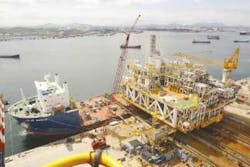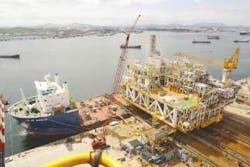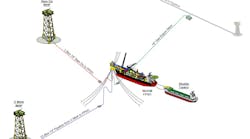The semisubmersible heavy transport vessel Blue Marlin has installed two topsides on pre-installed jackets for ConocoPhillips' Bayu-Undan gas recycl-ing development in the Timor Sea. A contract that Perth-based Clough Aker Joint Venture awarded Dockwise covered transportation and installation of the compression, utilities, and quarters (CUQ) and drilling, production, and processing (DPP) topsides.
Both packages were constructed at the Hyundai fabrication yard in Ulsan, South Korea. The CUQ topsides weigh 11,500 tons, with a length of 72 m, a width of 80 m, and a height of 31 m. The DPP topsides weigh 13,900 tons, with dimensions of 65 m long, 64 m wide, and 41 m high.
The transportation included two consecutive shipments using identical loading operations. Installation involved a float-over and mating operation using the vessel's ballast system and different types of shock absorbers between the stabbing cones and jacket legs and between the topside and the deck support structures.
Vessel preparations
To provide sufficient clearance between the lower parts of the topside and the Blue Marlin during withdrawal from the jacket following installation of the topsides, a height restriction of 6 m was imposed on the buoyancy casings at the vessel's stern. This entailed removal of the entire port side casing. The height of the starboard casing was reduced from 28 m to just 5 m. This casing could not be dispensed with, as it houses essential systems for running the main engine and propulsion system. It was therefore provided with a temporary top part containing all necessary equipment for the engine room operation, i.e., exhaust gas and engine room ventilation. To comply with stability and watertight integrity requirements, the remaining part was closed and the inlets re-routed to protect their openings from water ingress.
Loading operation
The 57,021-ton dwt Blue Marlin loaded the CUQ topside at the Ulsan yard early in June, using a skid-on method over the port side of the vessel. To facilitate this operation, coordinated by HHI, four transversely positioned skid tracks, each 1m high, were installed in Batam.
The topsides – supported by eight deck support structures (DSSs) – were pulled onboard the vessel using four 560-ton strand jacks. The latter were installed on the sea-facing side of the DSSs, while their strands were connected to designated anchor structures installed on the starboard side of the vessel. To minimize friction, the DSSs were slid on PTFE Teflon pads. For the break-off from the topside's erection position, additional hydraulic jacks were pushed against the land-facing side of the DSSs to assist the strand jacks on the seaward sides.
Skidding of the DPP topsides over the port side of the Blue Marlin. (photo: ConocoPhillips)
null
Once the topside reached the final stowage position onboard the vessel, it was supported by the steel grillage. Then, the skid equipment was removed, and the seafastenings were installed. The DPP topsides were loaded on July 31 after the Blue Marlin had re-mobilized to Ulsan following the successful transport and installation of the CUQ topsides. The loading method was identical, re-employing the DSS units and skid tracks.
The CUQ topsides were discharged via a float-over and mating operation. CAJV performed the eEngineering and operational preparations, as well as the installation, and Dockwise developed and executed the ballast procedure for the Blue Marlin.
Once environmental and operational conditions were acceptable, the vessel was moored in front of the jacket via four pre-installed anchors, using the mooring winches and lines installed on the forward part of the vessel's deck. Then it was maneuvered inside the jacket with the assistance of three tugs, one at each side of the Blue Marlin and one on the opposite side of the jacket connected to the bridle at the vessel's stern. The entrance guide fender at the stern and sway fenders in the side provided a soft interaction between the vessel and the jacket legs. The clearance between the vessel and the jacket was only 14 cm at both sides.
After the vessel had attained its correct position inside the jacket, the surge stoppers were given a static compression by pulling with the tug connected to the bridle at the vessel's stern. Then the topsides weight was transferred from the DSSs to the jacket legs through rapid ballasting of the Blue Marlin. In this phase, the shock absorbers safely counteracted the environmental impact loads between the topside and the jacket legs and the DSSs on the Blue Marlin. When sufficient clearance had been reached between the topsides and the DSSs, the vessel was withdrawn from the jacket and the mooring lines were disconnected.
The DPP topsides were installed in exactly the same way, except for the Blue Marlin's heading inside the DPP jacket, which was reversed.
Traditionally barges, using tug assistance, perform float-over and mating operations. According to Dockwise, the advantages of using a self-propelled heavy transport vessel are:
- .Shorter transportation time compared to a tug-barge combination due to higher transit speed and less weather sensitivity,
- .Reduced accelerations and low motion responses
- .Less risk of damage and/or total loss during transportation, with lower costs for marine cargo insurance
- .Availability of an integrated, advanced, and controllable ballasting system for accurate and faster ballasting
- .Ability to build at distant fabrication locations
- .Ability to add the propulsion system to improve maneuverability during positioning inside the jacket.
For more information, contact [email protected].




